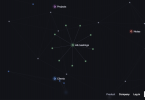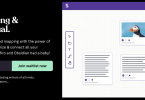I didn’t get up today thinking, “I’m going to create a new, visual way to outline the novel I’m writing.” But thanks to my Kindle, a service called Readwise, a smart note taking process, and a thought processor called Roam Research, several random and unrelated ideas collided, producing an insight I wouldn’t have had on my own.
Many Kindle Books, but Few Bright Ideas
I’m the sort of reader who used carry an extra backpack full of books on vacation. So when the Kindle launched in 2007, I received mine on day one. I love having my entire library accessible through one device — so much so that I’ve repurchased many books I already own, just to get them on my Kindle. Eventually, I became so enamored of the Kindle’s portability and features, I quit buying print books. If a book isn’t available on Kindle, I just won’t read it.
As someone who always circled, underlined, or wrote marginal notes near passages I found meaningful, I was pleased that the Kindle also supports highlighting and annotation. Like their handwritten parallels, these notes were easy enough to make, but, ultimately, neither my handwritten nor digital notes offered much in the way of practical utility. While I would stumble across my notes whenever I deliberately returned to a book, I had no way to surface those notes in any other context, no means of searching all my notes across all my books, and no system for linking related notes from different books together.
New Ways to Link Ideas Together
A few months back, I began using Roam Research, a thought processor with the ability to link information together in interesting and surprising ways. Notes in Roam don’t just sit around. I can link them together, associate them with projects or areas of interest, or explore the relationships Roam suggests. Over time, a network of ideas emerges — your “knowledge graph” — and this, in turn, becomes a tool for combining ideas in unexpected ways. Instead of a notebook, Roam Research is more of a collaborative partner that pushes you to write, publish, or do something with the information you collect.
At the same time, influenced by a book called How to Take Smart Notes: One Simple Technique to Boost Writing, Learning, and Thinking, I began taking more structured notes when reading, In an effort to push myself to combine ideas in interesting ways, I expanded on an idea from How to Take Smart Notes and created a Roam Research template I use to capture permanent notes, or single, granular ideas I want to rediscover later.
A Peek at My Roam Research Permanent Note Template
My permanent note template contains ten fields:
- Source: (a link back to the place the note came from)
- Keywords: ( single-word tags anticipating contexts in which I might want to see this information again)
- Project: (an optional field, linking this note to a project I’m considering or working on)
- Area: (an optional field, linking this note to an ongoing area of interest or responsibility in my life)
- Note: (the note itself)
- Similar to: (a prompt encouraging me to consider how this idea is like others I’ve come across before — and an opportunity to link this idea to those)
- Different from: (a prompt encouraging me to consider how this idea is different from others that come to mind — and a way to link this idea to those)
- Examples: (a prompt to think about ways this idea could be put into action, or to recall contexts in which I’ve seen this idea applied)
- Questions: (a prompt encouraging me to list ways this information might prompt me to learn or grow)
- Ideas: (a prompt encouraging me to list reflections, insights, or ideas for possible projects)
The template looks long here, but now that my thinking and research have been shaped by it, I fill it out very quickly. This structure, combined with Roam Research’s ability to cross-link ideas, has proven to be a powerful way to make static notes start dancing together (or, as Roam creator Conor White-Sullivan says, “Good ideas come from when ideas have sex: the intersection of different things that you’ve been reading or different things you’ve been seeing”).
Readwise Closes an Important Gap
The longer I used Roam, the larger and more complex my knowledge graph of inter-related ideas grew. One day, as I was highlighting passages in the Kindle version of the book Brave New Work, I realized what a shame it was that none of my Kindle notes and highlights, curated carefully over more than a decade, could get busy with each other in my Roam database.
So I started a project to copy and paste Kindle notes into Roam Research. I abandoned this project pretty quickly, though, in part because the process was brutally slow … and in part because I have 680 books in my Kindle library and, within these, more than 6000 notes and highlights. Even if I squeezed in the time to transfer ten notes a day, every day, from my Kindle to Roam, my project would take a year and a half to complete — more than that, really, since I’m adding new Kindle highlights every day.
One day, as I half-heartedly copied the day’s ten notes over, my Twitter feed brought me word of a new service: Readwise.io. With just a few clicks, Readwise imports highlights from Kindle, Apple’s iBooks, Instapaper, and other services, then surfaces a number of them in a daily email. (You can also convert highlights into flash cards and use spaced repetition — a strategy for integrating information into long-term memory — to keep information you found valuable top of mind.)
For someone with 6,000 Kindle highlights and notes, that proposal alone is intriguing enough. In addition, though, Readwise will export your Kindle notes into Roam Research.
Without hesitation, I plunked down my first monthly Readwise fee (about nine bucks) and clicked twice. In under ten minutes, Readwise pulled in all 6000+ Kindle highlights. I clicked once more, and in less than ten minutes, Readwise exported every single one of those highlights into a beautifully formatted pages in my Roam Research database. Oh, and it also organized them by book, created author pages, added tags, included the full text of each highlight, and added hyperlinks that jump to the related passage in the book from which the highlight came.
Instant Benefits
Over the months I’d been using Roam Research, my personal knowledge graph had been slowly growing in size and complexity. But thanks to Readwise, in mere minutes, that graph now contained thousands of new nodes gleaned from more than a decade of reading. In practical terms, that meant every idea that ever caught my eye in every book I’ve read since 2007 was now available to be resurfaced, linked, explored, repurposed, and put to work.
Remember that little pill Bradley Cooper takes in Limitless to instantly expand his intelligence? Readwise plus Roam is the digital equivalent.
On the third day after receiving this infusion of information, Readwise’s daily review of previously-taken notes surfaced a highlight I’d made (and promptly forgotten) in David Lynch’s Room to Dream. In it, Lynch mentions Frank Daniel’s “sequencing paradigm” for screenwriters, which involves taking seventy note cards, writing an element of a scene on each, and then organizing the cards into a sequence that makes sense — an outline for a screenplay.
Lynch’s note for screenwriters prompted a vague memory of something I’d once read for novelists. In seconds, a quick search in Roam for the term scenes took me to a Kindle highlight from Larry Brooks’s Story Engineering. In that book, Brooks argues for the utility of thinking of a novel in terms of four acts, each containing fifteen scenes. Brooks suggests writers begin by identifying and fleshing out a dozen or so key scenes (plot points, pinch points, midpoint, etc.), then working to “fill in the gaps” between these as a way of completing a novel’s outline.
As I thought about the similarities between Daniel’s seventy-scene sequencing paradigm and Brooks’s sixty scene approach to novel outlining, I found myself wishing for a tool powerful enough to help me visualize an entire novel at once — a sort of interactive whiteboard, pre-populated with scene cards, that might capture a novel’s structure at a glance. Without really knowing why, I found myself pulling up Roam Research notes from a conference call last week … and right there, in my meeting notes, was a reference to Miro.com, a simple but powerful white board app.
Fifteen minutes later, I’d built a novel outlining template in Miro functional enough to support a hybrid version of Daniel and Brooks’s card-based approach … and more flexible and customizable than I’d found in dedicated software for novelists.
Powerful Tools Yield Powerful Insights
Could I have made these associations and built this tool for myself without collaborating with Readwise and Roam? Maybe, with time … but not this quickly … and, I think, perhaps not at all. Building a visual novel outliner wasn’t on my “One Thing” list for that day … or on my list of long-term projects. The sequence of events leading to that action depended pretty solidly on Readwise’s ability to liberate and surface my notes and Roam’s ability to link and explore them. It was only when Readwise invited my notes to Roam’s “idea orgy” — thanks for that visual, Conor White-Sullivan — that these bits of information yielded useful insights.
If you care at all about the highlights you’re making in your Kindle books, you need Readwise. If you want to expand your personal knowledge graph with rich, meaningful data points, you can export thousands of Kindle highlights into Roam Research in minutes. And if you want a thought processor capable of forging new and unexpected connections among your ideas, there’s simply no better tool out there than Roam Research.
Note: As always, the opinions I express here are my own. I have not received compensation of any kind, including any free services (except for free trials available to the general public) in exchange for this post.
If you’re interested in Readwise, you can get an additional free month of service in addition to the free trial by using this sign-up link. When you do, because I’m already a paid subscriber, I won’t receive anything at all in exchange.
Some links in this post are Amazon associate links; if you click them and buy anything during your visit to Amazon, I may receive a few pennies of Amazon credit, which I will use to feed my hungry babies.
Cover photo by Balázs Kétyi on Unsplash







